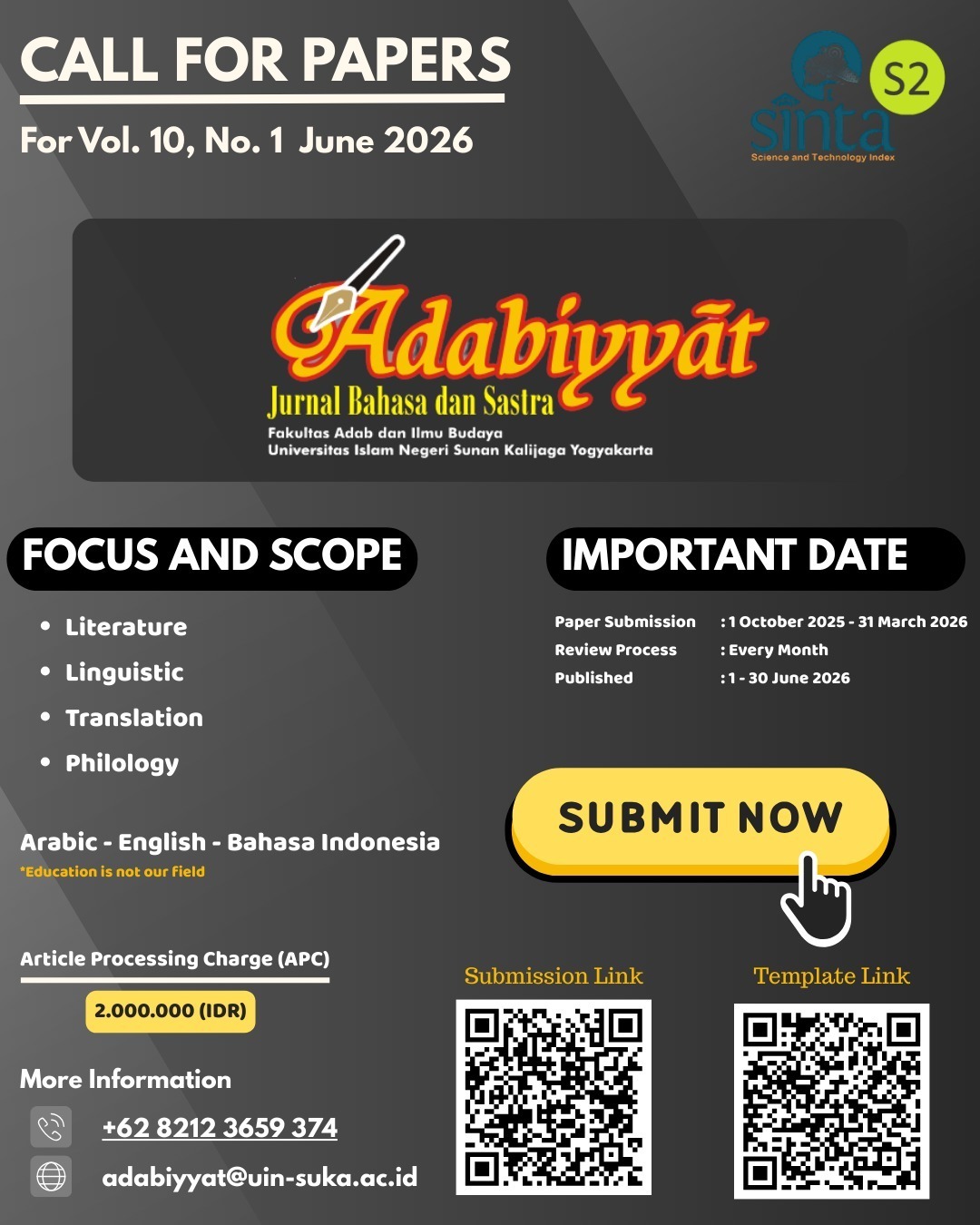TEKNIK APROKSIMASI DALAM PERESTRUKTURAN KLAUSA EKSISTENSIAL: KASUS PENGINDONESIAAN NOVEL SERIAL HARRY POTTER KARYA J.K. ROWLING
DOI:
https://doi.org/10.14421/ajbs.2011.10205الملخص
This study aims to explain the implementation of approximation technique in clause restructuring to produce a target language text, which is functionally equivalent with its source language counterpart. It is deliberately designed to analyze existential clauses contained in an English novel along with its Indonesian translation. Four basic steps, which has been taken to process the data, are (1) data reduction, (2) data display, (3) data analysis, and (4) inference. It is revealed that a number of restructuring phases are employed to achieve functional equivalence. These phases are taken due to the fact that the basic elements of existential clauses in English do not have any one-to-one formal correspondence with their counterpart in Indonesian. Through approximation technique, existential clauses are then restructured according to their communicative or interactive functions. Clauses, which refers to existence, are restructured to form clauses on "being", while those, which refers to events, are restructured according to their types or categories.
التنزيلات
المراجع
Baker, M. 1992. In Other Words: A Coursebook on Translation. London: Routledge.
Bell, R.T. 1991. Translation and Translating: Theory and Practice. London: Longman.
Catford, J.C. 1965. A Linguistic Theory of Translation. London: Oxford University Press.
Eggins, S. 1994. An Introduction to Systemic Functional Linguistics. London: Pinter.
Halliday, M.A.K. 1985. An Introduction to Functional Grammar. London: Arnold.
Halliday, M.A.K. 2001. Towards a theory of good translation, di dalam E. Steiner dan C. Yallop, 2001, hlm.13-18.
Halliday, M.A.K. 2004. An Introduction to Functional Grammar (Revised Edition by Ch. M.I.M. Matthissen). London: Arnold.
Hatim, B. 2001. Teaching and Researching Translation. Harlow: Pearson Education.
Hatim, B. dan I. Mason. 1997. The Translator as Communicator. London: Routledge.
House, J. 1987. Translation Assessment: A Model Revisited. Tubingen: Guenter Narr Verlag.
Hu, Y. 2000. The Sociosemiotic Approach and Translation of Fiction. Translation Journal. http://www.ocuparid.com. October
Leonardi , V. 2000. Equivalence in Translation: Between Myth and Reality. Translation Journal. http://www.ocuparid.com. Oktober
Lock, G. 1996. Functional English Grammar: An Introduction for Second Language Teachers. Cambridge: Cambridge Language Education.
Machali, R. 1998. Redefining Textual Equivalence in Translation with Special Reference to Indonesian-English. Jakarta: The Translation Center.
Matthiessen, C. 1995. Lexicogrammatical Cartography: English System. Tokyo: International Language Sciences Publishers.
Munday, J. 2001. Introducing Translation Studies. London dan New York: Routledge.
Newmark, P. 1988. A Textbook of Translation. New York: Prentice Hall.
Nida, E.A. 1964. Toward a Science of Translating. Leiden: E.J. Brill.
Nida, E.A. dan C.R. Taber. 1974. The Theory and Practice of Translation. Leiden: E.J. Brill.
Rowling, J.K. 1997-2006. Harry Potter Series. London: Bloomsbury. Dan terjemahannya: Srisanti. L. 2000-8. Seri Harry Potter. Jakarta: Gramedia.
Steiner, E. and C. Yallop. Eds. 2001. Exploring Translation and Multi-lingual Text Production: Beyond Content. Berlin: Mouton De Gruyter.
Thomson, G. 1996. Introducing Functional Grammar. London: Arnold.
Venuti, L. (ed.) 2000. The Translation Studies Reader. London/New York: Routledge.
التنزيلات
منشور
إصدار
القسم
الرخصة
- Adabiyyāt: Jurnal Bahasa dan Sastra publishes all articles entirely in full text.
- It is permissible for readers to download and to use it for scientific purposes and scientific dissemination.
- The author can re-publish the article that has been published by the Adabiyyāt: Jurnal Bahasa dan Sastra after obtaining written permission from the editor. This letter can be obtained by submitting a request letter for permission to republish the article to Adabiyyāt: Jurnal Bahasa dan Sastra via email adabiyyat@uin-suka.ac.id. In the second publication, the author is required to include information that the article was firstly published by the Adabiyyāt: Jurnal Bahasa dan Sastra.




















